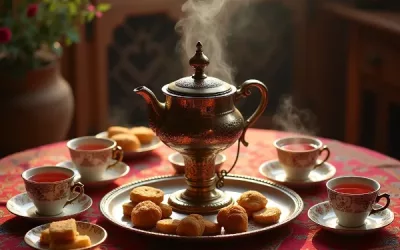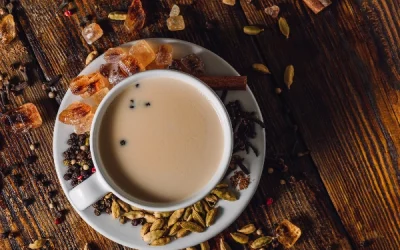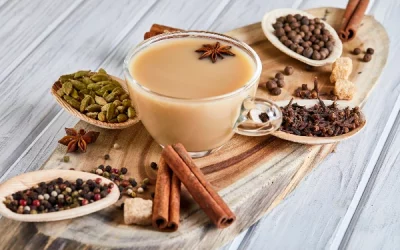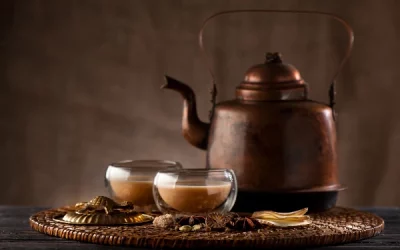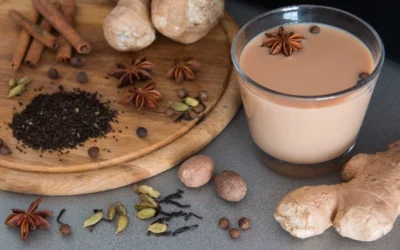As a fellow tea lover, I understand the desire for a delightful brew that caters to your health-conscious lifestyle or dietary needs. In this article, I’ll guide you through the essential ingredients, health benefits, and customisation options for a delicious milk-free chai tea. Whether you’re exploring non-dairy alternatives or seeking quick and easy methods, I’ve got you covered. Join me as we discover how to create the perfect cup of chai that not only tastes amazing but also aligns with your wellbeing goals!
Table of Content
- Can I make chai tea without milk?
- Can I make chai tea without milk
- What are the health benefits of chai tea without milk?
- How can you customise your milk-free chai tea to suit your taste?
- What are some common mistakes to avoid when making milk-free chai tea?
- How can you make a quick and easy milk-free chai tea at home?
- What are the basic ingredients needed for a quick chai tea?
- What are the steps to follow for a quick preparation?
- How can you save time while making chai tea?
- What are the steps to follow for a quick preparation?
- Can you use chai tea bags to make milk-free chai tea?
- What are some creative ways to serve milk-free chai tea?
- Conclusion
Can I make chai tea without milk?
Absolutely! Making chai tea without milk is not only possible, but it can also be a delightful experience. The robust spices in chai tea don’t lose their charm if you decide to skip the milk. In fact, going milk-free can bring out a new depth of flavours.
Imagine sipping a warm, aromatic cup of spiced tea that dances on your taste buds, without the creaminess of milk. Whether you have dietary restrictions or prefer a lighter drink, milk-free chai tea is an excellent option.
What are the essential ingredients for milk-free chai tea?
To make a delicious cup of milk-free chai tea, you need a few key ingredients. These will help you create a brew that’s rich, spicy, and full of character:
- Traditional spices like cardamom, cinnamon, ginger, cloves, and black pepper.
- High-quality tea leaves, typically black tea.
- Sweeteners such as honey, agave syrup, or sugar for some added sweetness.
- Fresh, filtered water to steep your tea.
- Optional non-dairy alternatives like almond milk, soy milk, or oat milk if you want a creamier texture.
What spices are typically used in chai tea?
Spices are the heart and soul of chai tea. They give it that warming, complex flavour profile that many of us crave. Here are the essential spices usually found in chai tea:
- Cardamom: Adds a sweet, floral note.
- Cinnamon: Brings warmth and a slight sweetness.
- Ginger: Gives a spicy kick.
- Cloves: Introduce a pungent, earthy quality.
- Black Pepper: Offers a subtle heat.
These spices not only taste amazing but also bring numerous health benefits, such as aiding digestion and boosting circulation.
What types of tea leaves are best for chai tea?
Choosing the right tea leaves can make or break your chai tea. Here are some ideal choices:
- Black Tea: The most traditional and robust choice, offering a full-bodied flavour.
- Assam Tea: Known for its strong, malty profile.
- Darjeeling Tea: Provides a lighter, more floral flavour.
- Rooibos Tea: Caffeine-free alternative with a naturally sweet taste.
Stick with high-quality, loose-leaf tea for the best results, and you’ll enjoy a richer, more aromatic brew.
What sweeteners can be used in milk-free chai tea?
Sweeteners can elevate your chai tea, giving it a balance of sweetness and spice. Here are some excellent options:
- Honey: Adds a natural sweetness and richness.
- Agave Syrup: A low-glycaemic index option.
- Maple Syrup: Offers a unique, caramel-like flavour.
- Coconut Sugar: Adds a subtle, tropical taste.
- Stevia: A calorie-free alternative.
Experiment with different sweeteners to find what works best for you. Each one brings a unique element to your cup of chai.
The tradition of drinking chai tea dates back to ancient India. In the royal courts of the Mughal Empire, chai was a cherished beverage. Emperor Shah Jahan, famed for constructing the Taj Mahal, was known to host lavish tea ceremonies.
Spicy brews would be prepared to impress and delight his guests, with tea masters carefully crafting each cup. It’s fascinating to think that, even then, people savoured the same blend of spices that we enjoy today, albeit in a grander setting.
On a more personal note, I remember the first time I made chai tea without milk. I had run out of dairy one cold winter evening and decided to give it a shot, substituting water and a splash of almond milk. To my surprise, the spices seemed even more vibrant, and the tea leaves released their full-bodied flavour. This “accidental” discovery turned into a preferred method for me. Try making your own milk-free chai; you might just find it a refreshing twist!
Can I make chai tea without milk
Yes, you can definitely make chai tea without milk. Chai tea, a popular spiced beverage originating from India, usually features a blend of tea, spices, milk, and sweetener. However, for those with dietary restrictions or personal preferences that preclude the use of dairy milk, there are many alternatives available.
These alternatives include non-dairy milk options, each providing its unique taste and texture to the chai tea experience. Understanding the subtleties of these options can help you craft a chai tea that suits your palate and dietary needs.
How do different non-dairy alternatives compare for making chai tea?
Comparing non-dairy alternatives requires attention to the flavor, texture, nutritional benefits, and overall suitability for chai tea. Below is a table that compares these elements:
| Non-dairy Milk Type | Flavour Profile | Texture | Nutritional Benefits | Suitability for Chai Tea |
|---|---|---|---|---|
| Almond | Mild, slightly nutty | Light, watery | Low in calories, high in vitamin E | Great for a lighter chai with a nutty hint |
| Soy | Neutral, slightly sweet | Creamy, thick | High in protein, rich in B vitamins | Ideal for creamy, richly flavoured chai |
| Coconut | Sweet, tropical | Thick, creamy | Medium chain triglycerides (MCTs), lauric acid | Adds a rich, coconutty twist |
| Oat | Mild, slightly sweet | Creamy, smooth | High in fibre, often fortified with vitamins | Perfect for a creamy texture without strong aftertaste |
| Rice | Sweet, slightly watery | Thin, watery | Low in fat, often enriched with calcium | Best for very light, subtly flavoured chai |
| Cashew | Creamy, slightly nutty | Very creamy | Heart-healthy fats, good source of magnesium | Excellent for a rich, nutty chai |
This table is designed to help you select the best non-dairy milk for your chai tea needs. You can see how each option fares in terms of flavour, texture, nutritional benefits, and suitability for creating your perfect chai.
Flavour profile and texture
Non-dairy alternatives offer a range of flavours, from nutty to subtly sweet. To choose the best option, consider these aspects:
- Almond milk has a light, slightly nutty taste that blends well with spices.
- Soy milk provides a creamy texture with a neutral flavour.
- Coconut milk adds a sweet, tropical twist.
- Oat milk offers a creamy, smooth texture with a mild sweetness.
- Rice milk has a thin texture with a hint of sweetness.
- Cashew milk delivers a very creamy consistency with a rich, nutty flavour.
The texture of these milks can make a significant difference in the final taste of your chai tea. For a creamier chai, soy, oat, or cashew milk are excellent choices. If you prefer a lighter option, almond or rice milk might suit you better.
Nutritional benefits
Each non-dairy milk brings its own set of nutritional advantages. Here are some key points to remember:
- Almond milk is low in calories and rich in vitamin E.
- Soy milk is a great source of protein and B vitamins.
- Coconut milk contains healthy fats like MCTs and lauric acid.
- Oat milk is high in fibre and often fortified with essential vitamins.
- Rice milk is low in fat and typically enriched with calcium.
- Cashew milk offers heart-healthy fats and is a good source of magnesium.
These benefits can complement your dietary needs, making your chai tea not only delicious but also nutritious.
Years ago in India, chai wallahs, or tea vendors, became an integral part of daily life. They would brew fresh chai tea by the roadside, each with a unique blend of spices and tea. One famous chai wallah, Raju, became renowned in his village for his special dairy-free chai.
His secret was using coconut milk, which added an exceptional richness. People from neighbouring villages would travel just to taste Raju’s chai. His story became legendary, proving that dairy isn’t essential for a great chai experience.
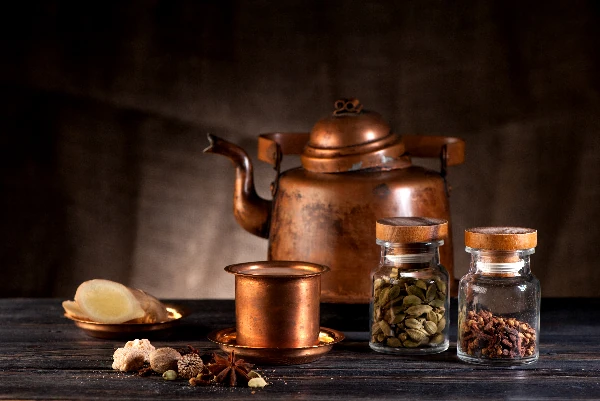
What are the health benefits of chai tea without milk?
Chai tea is the magical concoction from India that promises not only a jolt of flavour but a myriad of health benefits. But if the whole cow thing doesn’t sit well with you, you should know it’s perfectly possible to make chai tea without milk and still garner all its goodness.
For starters, if you’re aiming to keep your waistline in check, skip the milk and you’ll save a bunch of calories. Additionally, those lactose intolerant souls no longer need to suffer from unwanted digestive dramas. Intrigued yet? Well, keep sipping because this tea also boasts antioxidant properties and can be a pal when managing your weight.
How does milk-free chai tea help in reducing calorie intake?
Let’s get real – milk adds calories. One cup of whole milk can easily add up to around 150 calories. When you go milk-free with your chai tea:
- You dodge those extra calories.
- Honey, if used instead of sugar, can be kept in moderation.
- You cut down saturated fats, which are synonymous with milk.
- Lower overall calorie count means fewer concerns about your fitness goals.
This means you can relish the spicy goodness without second-guessing your calorie count. Also, your pants might thank you.
What are the benefits for people with lactose intolerance?
For the lactose intolerant gang, drinking dairy-laden chai tea is like signing up for a wrestling match with your intestines. Going milk-free:
- Eliminates the risk of bloating.
- Prevents the uncomfortable gas scenario.
- Stops those sudden bathroom trips – chilling the digestive dance.
- Makes chai a crowd-pleaser, even for those with lactose intolerance.
You get all the chai goodness without the intestinal rebellion. And trust me, your gut will praise you.
What are the digestive benefits of the spices used in chai tea?
Chai tea isn’t just a flavour party; it’s a digestive delight. The spices used bring in a variety of benefits:
- Ginger, known for its anti-inflammatory properties, aids digestion.
- Cardamom, fancy as it sounds, helps detox and improve digestion.
- Cinnamon might remind you of grandma’s pie, but it stabilises blood sugar levels.
- Cloves have antiseptic properties and help in reducing digestive-related discomforts.
- Black pepper can increase metabolism, aiding digestion.
This spicy blend essentially gives your digestive system a well-rounded boost while you enjoy a cuppa.
In the 19th century, British colonialists in India popularised the concept of ‘afternoon tea’, but the local Indians thought – why not enhance it with a blend of spices? Thus, we got masala chai.
When rationing milk during the Second World War, many had to turn to milk-free versions of their drinks, deliciously spiced chai tea became the healthier, zestier alternative. Proof that some great things arise out of necessity! So, next time you savour your milk-free chai tea, remember you’re partaking in a little slice of tea history. Cheers!
How can you customise your milk-free chai tea to suit your taste?
Alright, welcome to the world of milk-free chai tea customisation! You’ve bravely decided to skip the milk, and now you’re probably lost in a sea of spices, sweeteners, and tea leaves, wondering how to make your perfect blend. Fear not, for I am here to guide you.
We’re going to tackle how to adjust spice levels, choose the right sweeteners, experiment with tea leaves, add non-dairy creamers, and incorporate some unique flavours. By the end of this, you’ll be a chai-concocting whiz!
So, let’s dive into how you can turn your milk-free chai tea into the masterpiece of your dreams.
How can you adjust the spice levels in your chai tea?
Adjusting the spice levels in your chai tea is akin to being a mad scientist, minus the crazy hair and the penchant for accidentally creating monsters. Here’s how you can fine-tune those flavours:
- Start with the basics: Use a base of classic spices like cardamom, cinnamon, ginger, and cloves.
- Add a bit at a time: When in doubt, add a pinch rather than a handful. You can always add more if needed.
- Simmer longer for stronger flavours: The longer you let your spices simmer, the stronger the flavour will be. Steep responsibly.
- Go mild or wild: Prefer a milder chai? Cut down on the ginger. Want it fiery? Go nuts with those cloves and black pepper.
- Mix and match: Feel free to experiment with star anise, fennel seeds, or even a dash of nutmeg.
Remember, the goal is to make a chai tea that dances on your taste buds, not assaults them.
What are some alternative sweeteners you can use?
Sugary chai is so yesterday. If you’re looking to keep your tea sweet without diving into a sugar coma, check out these alternative sweeteners:
- Honey: The classic choice, rich and slightly floral. Perfect for a warm, cosy cup.
- Maple syrup: Adds a unique depth and a hint of maple goodness.
- Stevia: Great if you’re counting calories but still crave sweetness.
- Coconut sugar: A bit richer and more complex than your average table sugar.
- Agave nectar: Subtle and smooth, with a lower glycaemic index.
Your sweetener should complement your spices, not drown them. Think of it as a delightful background singer, not the eager rock star stealing the show.
How can different tea leaves affect the flavour of chai tea?
Tea leaves are the unsung heroes of chai tea, impacting the overall flavour profile in ways you might not have considered:
- Black tea: The traditional choice, with a strong, robust flavour.
- Green tea: Lighter and more delicate, perfect if you want a subtle base.
- Rooibos: Naturally caffeine-free and slightly sweet, great for evening indulgence.
- Oolong: Somewhere between black and green, with a complex, layered flavour.
- Herbal blends: Experiment with chamomile, peppermint, or hibiscus for a unique twist.
Remember, each type of tea leaf brings its own personality to the mix. So, experiment and find your chai soulmate.
Adding non-dairy creamers like almond or oat milk can also change the texture and flavour of your chai tea, making it creamier without the dairy. You can also explore adding unique flavours like vanilla, chocolate, or even a splash of orange zest for something truly special. Remember, the perfect cup of chai tea is all about balance and personal preference.
Speaking of unique flavours, did you know George Orwell, the famed author of “1984” and “Animal Farm,” was a fan of tea and even wrote an essay titled “A Nice Cup of Tea”? In his essay, Orwell shared his 11 golden rules for making the perfect cup of tea.
While he didn’t cover milk-free chai per se, his passion for finding the right balance and flavour can inspire your own chai-making adventures. Harness that Orwellian attention to detail, and you’ll be crafting the ideal cup in no time.
What are some common mistakes to avoid when making milk-free chai tea?
Let’s spill the tea, shall we? Making milk-free chai tea isn’t rocket science, but a few common pitfalls might leave you sipping something that tastes more like hot mess than heaven. You don’t want your chai experience to be a bitter brew, so let’s dive right in.
Firstly, let’s talk about over-brewing. If you leave your tea leaves in the water like you’re trying to set a world record for steeping, you’ll end up with a bitter concoction. Not ideal for a relaxing cup, right? Then there’s the spice conundrum. Chai without the perfect spice blend is like a joke without a punchline—disappointing. Too much spice, and it feels like a fire-breather’s tea. Too little, and you’ve got a bland brew.
Sweeteners also need balance. Too much sugar makes it a dessert, too little makes it a mouth-puckerer. Speaking of mistakes, incorrect water temperature can be a straight-up catastrophe for your chai. And don’t get me started on straining poorly—you’d basically be drinking liquid with chunks, not exactly appealing.
What happens if you over-brew the tea?
So, you’ve decided to be generous with the steeping time. Maybe you got distracted on Instagram or took a little too much time pondering life’s mysteries. Unfortunately, over-brewing leads to one sad result—bitterness. As the tea leaves stay submerged for too long, they release tannins, compounds that create an unpleasant, astringent taste.
Here’s what to avoid:
- Steeping too long turns tea bitter.
- Over-brewing can bring out unwanted astringent flavours.
- Longer steeping doesn’t equal more flavour, just more of a bitter punch.
- Those delicate notes in your tea can get drowned out.
Make like Goldilocks: get it just right. Steep your tea for around 3-5 minutes like a boss, and you’ll get a brew that makes you want to come back for more, minus the bitterness hangover.
How can you ensure the right balance of spices?
Balancing spices in your chai tea is a bit like doing the cha-cha—you need the right rhythm to make it delightful. Dumping in spices willy-nilly will either set your taste buds on fire or leave them yearning for more. Get it right, and you’ll have a flavour symphony in your cup.
Steps to nail the balance:
- Use whole spices for stronger, more rounded flavour.
- Pre-ground spices can be overpowering, so tread lightly.
- Start small with potent spices like cloves and cardamom.
- Taste as you go; your taste buds are your best guide.
- Consistency is key, keep a standard spice mix ratio.
Spices like cinnamon, ginger, cloves, and cardamom are your friends, but too much of a good thing can turn into too much of a bad thing real quick. Remember, you can add more spice later, but you can’t un-spice it!
What is the ideal water temperature for brewing chai tea?
Ah, water temperature—the often overlooked hero of brewing. Get it wrong, and your chai could turn out like a sad show at the fringe.
Don’t boil your tea to oblivion. Water that’s too hot will scorch the tea leaves, ruining the delicate flavours. Aim for a cozy 90-95°C (194-203°F)—enough to coax out those beautiful flavours without any bitterness.
Ideal water temperature tips:
- Microwaving water can give inconsistent results.
- Invest in a good kettle with temperature settings.
- Use a thermometer if you want to be precise.
- Let boiled water cool for a few minutes before adding tea.
- Consistency here makes a noticeable difference in flavour.
Get yourself a good kettle with temperature settings or a thermometer if you’re feeling particularly fancy. Trust me; this small step makes a big difference in avoiding bitter or weak tea.
How can you make a quick and easy milk-free chai tea at home?
A craving for chai tea usually means a desire for that unique blend of spices – but without the milk. Making a milk-free version at home is simpler than you might think. You just need a few basic ingredients and a follow-along process.
This method is faster than trying to decipher ancient scrolls of chai wisdom. Plus, you can make larger batches to save future you from unnecessary hassle.
What are the basic ingredients needed for a quick chai tea?
First things first: ingredients. You don’t need a pantry full of exotic spices to craft a tasty milk-free chai tea. Here’s the essentials list:
- Tea: Traditional black tea is the go-to. But if you’re feeling rebellious, green or herbal like rooibos will work too.
- Water: The base. You can’t make tea without it.
- Spices: Star players include cinnamon, cloves, cardamom, ginger, and black pepper. Spice mixes are like those VIP passes in concerts – they make everything better.
- Sweetener: Sugar, honey, or an underappreciated cousin like agave syrup. Your call.
- Optional Extras: Maybe a little vanilla extract or some orange peel if you’re feeling adventurous.
This humble assortment is your toolkit to a fantastic milk-free chai tea. No milk, no problem.
What are the steps to follow for a quick preparation?
Alright, time for a brew-tiful adventure. Here’s the roadmap to your perfect cup of milk-free chai tea:
- Boil Water: Start with a pot of water. Aim for one cup per serving.
- Add Tea: Toss in your black tea. One teaspoon per cup is usually spot on.
- Spice It Up: Add your spices. If you’re using whole spices, crush them a bit to release their magical essence.
- Simmer: Let it simmer for about 5-10 minutes. Think of it as a spa day, but for tea.
- Sweeten the Deal: Add your sweetener of choice to the pot. Stir till dissolved.
- Strain and Serve: Strain the tea into your cup. Sip away, imagining you’re in an exotic market (or your kitchen – whatever works).
Basic steps, basic bliss. You’ve turned a few humble components into a cuppa that even the spice gods would approve of.
How can you save time while making chai tea?
Now, let’s talk efficiency. Time-saving hacks are what separate the chai connoisseurs from the chai noobs. Here’s how to guerrilla your way through the tea-making process:
- Pre-mixed Spice Blends: Find or make a good spice mix. These blends mean less time measuring and more time enjoying.
- Bigger Batches: Multiply those ingredients. Make enough for a shy marathon of tea sipping. Store in the fridge for a few days and simply reheat.
- Tea Bags: You can use pre-portioned chai tea bags instead of loose leaf. Less mess, less fuss.
- Spice Pouches: Rather than adding loose spices, tie them up in a cheesecloth – an easier cleanup post-simmer.
- Electric Kettle: Use an electric kettle to hasten the water boiling process. It’s faster and more convenient than traditional stove methods.
Efficiency is the name of the game. These shortcuts let you enjoy your drink with minimal faff.
What are the steps to follow for a quick preparation?
Streamlining the preparation ensures your investment in chai-tastic flavour doesn’t drain your schedule. Power through with these tips:
- Boiling Water: Use an electric kettle to speed up the boiling process.
- Pre-cut Spices: Having your spices ready to go in a container makes the mixing stage a breeze.
- Batch Brew: Simmer larger batches and store them in the fridge. It’s tasty and time-efficient.
- Ready Sweeteners: Using liquid sweeteners like honey or syrups eliminates the need to wait for granules to dissolve.
- Reusable Strainers or Bags: They are easy to clean-up and can hold all your spices in one go.
With these hacks, your chai tea game can be both savvy and swift.
In the grandeur of tea history, there’s a tale of the Indian monk Bodhidharma, who is credited with bringing Buddhism to China. Legend has it that during a long meditation, he struggled with sleepiness.
He chewed some wild leaves, which killed his drowsiness and birthed a plant we now know as “tea.” So, as you enjoy your milk-free chai, remember that great ideas – like this delicious blend – often come from simplicity and necessity.
Enjoy your tea, and may you stay as energetic as Bodhidharma!
Can you use chai tea bags to make milk-free chai tea?
Absolutely, you can! Brewing chai tea without milk is not only possible but also a simple process that doesn’t require you to be the next Great British Bake Off winner. Let’s dive right into how you can turn your chai tea bags into a comforting, aromatic cup of tea, sans the milk.
Convenience and nitty-gritty details
Chai tea bags are like the instant noodles of the tea world. They’re convenient, pre-measured, and ready to go. Ideal for those moments when you’ve just rolled out of bed and need a pick-me-up without the fuss. Plus, they allow you to enjoy the spicy, warming flavors of chai without needing to have a full-on tea ceremony.
Chai tea bags come with a variety of flavor profiles and brewing times, and the market is flooded with options. It’s essential to choose high-quality tea bags if you don’t want your cup of chai to taste like a wet sock. Some come pre-spiced, while others are more traditional and leave the spicing up to you.
How do chai tea bags differ from loose tea leaves?
Chai tea bags: convenient, but let’s be real—they don’t hold a candle to the nuanced flavors of loose tea leaves.
- Ease of use: Tea bags are pre-measured and quick.
- Flavor: Loose tea leaves usually offer richer, more complex flavors.
- Quality: Loose leaves often come from higher-quality plants.
- Variety: Tea bags have fewer options in terms of spice blends.
- Price: Tea bags can be a budget-friendly option.
Loose tea lovers will tell you the depth of flavor you get from loose leaves is unmatched. But hey, tea bags have their place, especially when you need your chai fix pronto.
What is the recommended brewing time for chai tea bags?
Remember, patience is a virtue. The perfect cup of chai tea brewed with tea bags generally takes around 5-7 minutes. Anything less, and you might as well be drinking hot water with a hint of sadness.
- 5-7 minutes: Ideal time for extracting full flavor.
- Less than 5 minutes: Weak, sad chai.
- More than 7 minutes: Bitter and overpowering.
The key is to allow enough time for the spices and tea leaves to fully infuse, giving you a robust, warming cup of chai.
How can you enhance the flavour of chai tea made with tea bags?
Spicing things up is more than just a metaphor—it’s a tactic.
- Fresh Spices: Add a stick of cinnamon, a few cardamom pods, or a sliver of fresh ginger.
- Sweeteners: Honey, maple syrup, or even a touch of brown sugar can elevate the experience.
- Citrus Zest: A bit of orange or lemon zest adds a refreshing twist.
- Herbs: Mint or basil leaves can give the tea a fresh kick.
- Strong Brew: Use two tea bags if you want a spicier punch.
With these little tweaks, your chai can go from bland to wowza in no time.
As promised, here’s a nugget from history. The Brits might have popularised tea, but the Indians totally owned it with chai. In the early 20th century, the British-owned Indian Tea Association began promoting chai heavily.
But here’s the twist: to cut costs, street vendors started adding spices, milk, and sugar to the tea. This wasn’t just a cost-saving measure; it made the tea uniquely delicious and turned it into the cultural staple we know today. So next time you’re sipping chai, remember it’s a blend not just of spices, but of history too.
What are some creative ways to serve milk-free chai tea?
Oh, chai tea, that magical, aromatic concoction from India that has the power to transport you to another realm with just one sip. But hey, not everyone wants milk in their chai. Maybe you’re lactose intolerant, maybe you’re a hardcore vegan, or perhaps you just can’t stand the stuff. Whatever the case, let’s dive into some exciting ways to serve this spiced brew without the dairy drama.
How can you make an iced version of milk-free chai tea?
Iced chai tea is like the cool cousin of the hot version. Perfect for those scorching summer days when you want your chai but without the steaming heat.
- Brew your chai: Steep chai tea bags or loose-leaf chai in hot water for about 5-7 minutes. We want it strong, like The Rock strong.
- Sweet as you like: Stir in some honey, sugar, or sweetener of choice while it’s still hot.
- Ice, ice baby: Pour the brewed tea over a glass full of ice. Throw in some lemon slices or mint leaves for that extra zing.
You can also add sparkling water if you fancy some bubbles, why not get adventurous? This spritz version will make you feel like you’re at a fancy café without spending those extra quid.
What are some recipes for chai tea lattes without milk?
Who doesn’t love a good latte? The thing is, you don’t need milk to make one that’s delish.
- Almond milk chai latte: Just swap out the regular milk for almond milk. Give it a whirl in the blender to froth it up like a hipster barista.
- Coconut milk chai latte: A tropical spin with coconut milk. Slightly heat and whip it up with a frother, and you’ll have a creamy, dreamy latte.
- Chai cashew milk latte: Cashew milk gives you a decadent, creamy texture. Simmer it with your chai spices for an extra kick.
- Oat milk chai latte: Oat milk is all the rage these days. It’s creamy and slightly sweet, making it perfect for a chai latte.
- Soy milk chai latte: Soy milk is a classic alternative and it’s easy to froth.
Remember to always heat your milk alternatives gently. Nobody likes a scorched latte, right?
How can you incorporate chai tea into desserts?
Chai tea-infused desserts are like little bites of heaven. They turn any basic sweet treat into something magical.
- Chai tea ice cream: Steep chai tea bags in your ice cream base before freezing. You’ll get that spiced flavour in every lick.
- Chai tea scones: Add chai spices to your scone dough. Bake and serve with a dollop of dairy-free cream.
- Chai cupcakes: Infuse your cupcake batter with chai tea. Top with spiced frosting, and you’ve got a dessert that’ll steal the show.
- Chai chocolate truffles: Mix in chai spices with your ganache before forming your truffles. Roll them in cocoa powder for a decadent treat.
- Chai panna cotta: Use agar-agar and coconut milk for a vegan panna cotta. Infuse with chai tea to elevate your dessert game.
The beauty of chai is that it pairs well with a variety of ingredients, making it versatile enough to be used in countless dessert recipes.
Conclusion
In conclusion, crafting delicious chai tea without milk is a delightful journey that not only caters to health-conscious individuals but also embraces a wider audience, including those with dietary restrictions. Throughout this guide, I highlighted the essential ingredients, such as traditional spices and tea leaves, that form the foundation of a flavourful, milk-free chai. We explored the diverse world of non-dairy alternatives, discovering their unique characteristics and suitability for enhancing the robustness of chai.
Moreover, I delved into the numerous health benefits associated with this milder version of chai tea, from reduced calorie intake to the digestive advantages provided by its rich spices. Customising your chai to suit personal tastes became an exciting opportunity for creativity, while recognising common pitfalls helped ensure that each cup is perfectly brewed. Whether you’re looking for a quick recipe or ways to enjoy chai in innovative forms, this guide offers ample inspiration.
As I reflect on the joys of brewing milk-free chai tea, I am reminded of the communal aspect of tea-drinking; it’s about sharing experiences and flavours, transcending dietary barriers. I encourage you to experiment, perhaps taking your love for chai to new heights by incorporating unconventional ingredients or sharing your creations with friends.
So the next time you’re pondering, “Can I make chai tea without milk?” remember this: chai, in its essence, is as versatile and comforting as it is traditional. How will you make your next cup uniquely yours?


